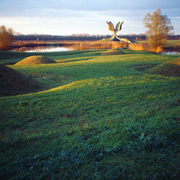
Jasenovac Memorial Site
The International Carlo Scarpa Prize for Gardens
XVIII Annual Award, 2007
The jury of the International Carlo Scarpa Prize for Gardens has decided unanimously to dedicate the 2007 award to a vast open space along a bank of the River Sava near the village of Jasenovac in Croatia, until 1941 the site of a brick kiln and from 1941 to 1945 a concentration camp; since then it has become a memorial site, an accretion of signs, sediments, testimonies and symbols that have been laid down in time and help us to come to terms with the question of the forms and beings of places to which communities entrust the task of keeping alive and focusing the memory of the finest or most tragic moments of their past.
The jury thought and talked long about the metamorphosis of mind-sets, about the anthropological processes by which, from a starting point of unspeakable awfulness, the memory of people and events can gradually be transformed first into a rational record, which eventually acquires the posture and textural depth of history. Investigation into the shockingly vast European catalogue of such places and reflection on their shared characteristics may not have led us anywhere near certainties, but the effort has at least brought into sharp focus the importance of the processes of memory, the need to apply resolute critical awareness to more than the mere accumulation of remains and the timely usefulness of a clearly conceived project. In this Jasenovac shows us how the safeguarding and maturing of memory can find a powerful ally in artistic invention. And how memory can itself become a place.
Here, at the beginning of the 1960s, a Serbian architect, “man of letters” and Mayor of Belgrade from 1982 to 1986, the now 85-year-old Bogdan Bogdanovic, accomplished an astonishing example of the art of landscaping. In the total absence of any physical remains of the brick kiln and of the concentration camp, all removed completely straight after the war, Bogdanovic employed miniscule movements of earth to create immensely moving reminders of the huts and facilities of the concentration camp: slight corrugations, almost invisible swellings under the skin of the vast meadow fringed with the row of willow trees that marks the edge of the river. And at the point where the reflective surface of water has been restored to an earlier bed of the river, he brought forth from the ground, from the bowels of the earth, something that looks like a literally sublime organic shape, an enormous, fantastic creature that has finally emerged to breathe and bask in the light, a monumentum whose task is to define the centre of gravity of the complex organism of this memorial space.
Text taken from the 2007 Carlo Scarpa Prize Statement, edited by the Jury.
